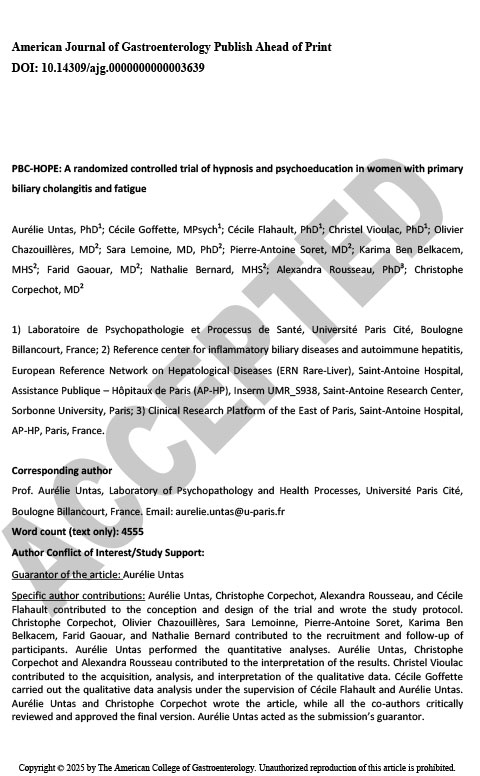PBC-HOPE: A randomized controlled trial of hypnosis and psychoeducation in women with primary biliary cholangitis and fatigue
July 2025
Abstract
Objectives: Fatigue is the main symptom of primary biliary cholangitis (PBC), but has not yet been improved by any therapeutic intervention. This study evaluated the efficacy and safety of hypnosis and psychoeducation in improving fatigue associated with PBC (PBC-HOPE ClinicalTrial.gov number, NCT03630718).
Methods: Fifty-five women with PBC and significant fatigue, defined by a PBC-40 atigue score ≥ 33, were randomly assigned to standard care (SC) alone (n=18), SC plus hypnosis (n=18) and SC plus psychoeducation (n=19), with four weekly sessions for the intervention groups. Self-report questionnaires, including the PBC-40, were completed at inclusion (D0) and Week 12 (W12). The first eight patients in each group were interviewed at both times. The primary outcome was the difference in PBC-40 fatigue score between D0 and W12. The secondary and exploratory outcomes were the psychometric scores and interview findings.
Results: The primary outcome was not achieved, with a median (interquartile range) difference in PBC-40 fatigue score of -3.0 (-10.0; 1.0), -6.0 (-8.0; -4.0), and -6.0 (-11.5; -4.8) for SC, SC-hypnosis, and SC-psychoeducation, respectively. The quantitative secondary outcomes were consistent with this result. The qualitative exploratory outcomes indicated that both interventions positively modi ied atients’ erce tions of fatigue, underlining the appropriation of the intervention. No serious adverse events occurred.
Discussions: At 12 weeks, hypnosis and psychoeducation interventions were not associated with a significant reduction in quantitative measures of fatigue associated with PBC. However, the qualitative changes in perceived fatigue associated with these interventions suggest that maintenance sessions could be beneficial in the longer term.
Copyright © 2025 The Author(s). Published by Wolters Kluwer Health, Inc. on behalf of The American College of Gastroenterology
Note: Obeticholic acid, marketed under the brand name Ocaliva® for the treatment of primary biliary cholangitis (PBC), was voluntarily withdrawn from the US market by Intercept Pharmaceuticals following a request from the US Food and Drug Administration (FDA) on 11/14/2025

